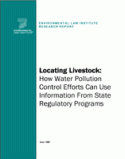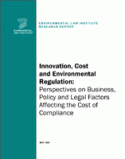
Research Reports
ELI publishes Research Reports available for free download that present the analysis and conclusions of the policy studies ELI undertakes to improve environmental law and policy. These reports contribute to education of the profession and disseminate diverse points of view and opinions to stimulate a robust and creative exchange of ideas. Those publications, which express opinions of the authors and not necessarily those of the Institute, its Board of Directors, or funding organizations, exemplify ELI’s commitment to dialogue with all sectors.
This report analyzed whether and how animal facilities potentially subject to regulation could be located using data from existing state regulatory programs. The study outlines existing programs that deal with water pollution from animal facilities, and it describes pollution-control and other regulatory programs that generate lists of animal facilities. It also suggests how water quality programs can work with other agriculture regulatory programs to encourage compliance with pollution control requirements.
Read More >
This report analyzes the legal and economic factors, and provides an assessment of the cost and benefits, associated with increasing the use of natural gas for electric generation. It looks at the important preliminary issue of whether there is an adequate supply of natural gas available. Five scenarios of future natural gas supply, based on similar data but differing assumptions of the rate of technical progress or price changes are presented below. These scenarios include, Official Estimates, Historical Trends, Rapid Technology Growth, Low Prices and High Prices.
Read More >
This report presents and synthesizes current research regarding the Porter hypothesis that theorizes the cost of implementing environmental regulations may be significantly reduced by low-cost processes and other innovations. The report offers various perspectives on the hypothesis, drawing from economics, organizational, and legal theory. An appendix to the report presents the summary of a workshop held on April 30th, 1999 that brought together some of the leading researchers on the subject.
Read More >
This report is intended as a handbook for all those working to conserve and protect New Mexico`s wealth of biodiversity and rich natural heritage. The goal of the report is to describe the state`s current laws and policies, identify gaps and opportunities for change, and encourage a dialogue about what the laws that affect our natural heritage should look like.
Read More >The best way to regulate the release of mercury to our environment is through pollution prevention — placing a declining cap on the use of mercury in products and processes. Such a cap could limit mercury releases to 10% of current levels from intentional uses, and 50% of process emissions by 2010. This approach would be far more effective than EPA`s current strategy based on emissions controls, because it achieves dramatically greater reductions in total mercury releases, and reduces the problems of re-releases of mercury from wastes.
Read More >